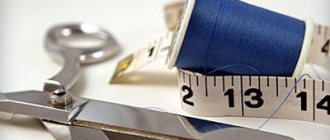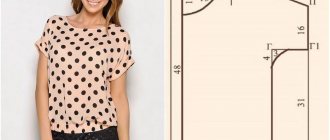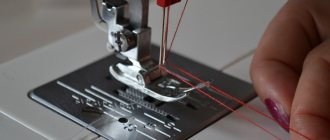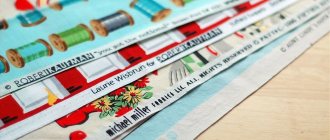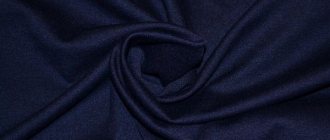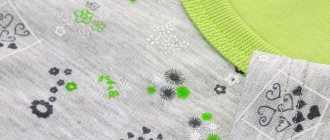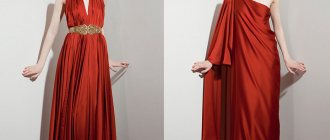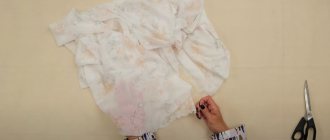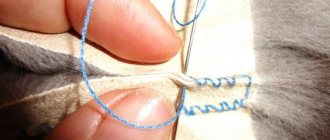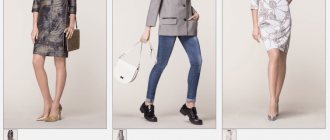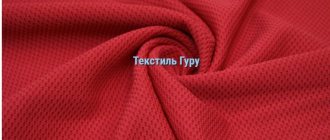Knitted clothing is very convenient and comfortable. Knitwear stretches and does not restrict movement at all, which is especially important for children.
Nowadays there is a large selection of cotton knitwear, that is, natural and hygienic. You can choose a variety of knitwear: from light and thin to thicker and warmer. Interlock, ribana, cashcorse, kulirny stitch, velor...
In general, sewing from knitwear for children is a pleasure!
And here the question often arises: How to sew knitwear if I don’t have an overlocker? And its presence is not expected in the near future. Is it possible to sew knitwear on a regular sewing machine?
I hasten to reassure you - it’s possible! It is clear that it is more convenient with an overlocker. But you can also sew knitwear without it.
Whatever type of knitwear you choose, you must follow some rules when sewing.
Below I will give some tips on how to sew knitwear on a machine.
You can gradually try them all and choose the one that suits you best. There are no universal methods, everything depends heavily on the knitwear itself, the specific sewing machine and the person sewing this knitwear at that machine :).
Knitting needles
- To sew parts made of knitted fabric, you need a well-chosen needle. Preferably - with a rounded end (such needles do not tear the loops, but push them apart). You can also use a universal needle, but first test its effect on a small section. It is especially necessary to use knitting needles when sewing thin and delicate fabrics, which unravel when pierced with ordinary needles. Thick cotton knitwear can sometimes be sewn with a regular needle, and it will not tear.
- It is also important to choose threads that are smooth and elastic. For example, nylon or long-fiber polyester, mostly polyester, are now sold, so finding the necessary threads in stores is not difficult.
- Seams. A narrow zigzag seam is suitable for sewing all types of knitted fabrics. If the fabric does not stretch very much, you can use a regular straight stitch, but then when stitching the parts you need to slightly stretch the material. The seam allowances need to be folded back, processed with an overlock stitch or the same “zigzag” stitch and ironed. If a very thin and elastic fabric is chosen, then an overlocker is preferable when stitching.
- If you don’t want individual parts to stretch (cuffs, pockets, neckline), then you can’t do without an adhesive pad.
- Knitwear can be sewn with a regular straight stitch. When sewing, stretch the material slightly (so that the threads do not burst during wearing). In this case, it is worth stretching only where there will be a line, and not stretching the allowance.
- You can sew with a narrow zigzag stitch: stitch width 0.5-1 mm, length 2.5-3 mm. You can further experiment with the width and length of the stitch on a specific material.
- If the set of stitches that the sewing machine performs includes a knitted one (many modern machines have it), it’s worth trying that too.
- Also, if the set of stitches that a sewing machine makes contains an overcast stitch, you can sew seams and fold the bottom of the product (you can use this overcast stitch to sew shorts)
- Many knitted fabrics do not unravel, so (secretly :)), the cuts do not need to be processed at all.
- Or you can stitch the sections with a zigzag, stitch width 5 mm.
- The bottom is very convenient to bend and hem with a double needle. On the front side, such a needle produces 2 parallel lines, and on the back side - a zigzag.
- If there is no double needle, you can lay 2 parallel lines, simulating a double needle.
- If the knitwear stretches a lot, and during the sewing process under the foot the parts move relative to each other, use the upper conveyor. This device is built above the needle plate and helps move the top layer of material.
- Sometimes, to make sewing easier, they put paper on top or bottom of the knitwear, and sew on the paper.
General rules for working with an overlocker
Working with an overlocker has its own characteristics.
Threading
Almost all overlocker models are equipped with a threading scheme; as a rule, it is “hidden” under the front cover. The same diagram is in the instructions for using the overlocker model. In order not to go through this path anew each time, it is enough to cut the threads from the old spools and tie them to new bobbins. Further, all refueling will be reduced to several actions:
- with the presser foot raised, pull through the needle thread;
- cut off the knot in front of the eye of the needle and thread the thread into the eye of the needle;
- the rest of the threads can simply be pulled through without cutting the knots; you need to pull carefully; a knot stuck in the pressure plates can break the fragile thread.
Seam selection
Most knitted items can be sewn entirely on a four-thread overlocker. The seam can be either three-thread or four-thread . The three-thread stitch is used for overcasting edges. If the material is thin, a narrow one with the left needle removed will do. For flat stitching on denser fabrics, you need to remove the right needle.
With four threads, you can sew knitwear and overcast the edges at the same time. For elastic knitwear, which, when stitched, goes in a “wave”, you can use differential feeding of materials, if such a function is available in the overlocker.
REFERENCE! To beautifully finish the edge of thin knitwear, for example, on a skirt, you can use a narrow rolled seam of three threads. To perform it, you need to pull the “tongue” in front of the foot, reduce the stitch width and adjust the thread tension. The bottom thread, which will be on the wrong side, should be tightened tighter than the rest. The differential feed can be adjusted to stretch if you want a wavy edge as a result.
When making a narrow three-thread rolled seam, you can not tighten the bottom thread, then you will get a double-sided edge seam “border”. It is good to use on parts where the wrong side is visible from the model.
The Flatlock seam is used to sew parts together with an imitation of flat stitching. It turns out when sewing two parts; the effect of a flat seam will be when unfolding and smoothing these parts.
REFERENCE! A narrow Flatlock is made using the left needle and two lower loopers; a wide Flatlock is made using the right needle and two lower loopers. There are features of thread adjustment: the needle thread must be loosened and the lower looper thread must be tensioned.
How to stitch
The overlocker is equipped with a sharp knife; it will be difficult to fix a cut part, so first you need to practice on scraps and inexpensive products to get your hands on.
The easiest work will be with straight seams. The materials to be sewn are placed under the presser foot. After lowering the presser foot, you can sew the pieces together. After finishing the stitching, you can sew a few more centimeters; the intertwined section will prevent it from unraveling between operations. If necessary, you can secure the seam by threading the remaining interlaced threads into the seam using a needle to lift the loops.
The work of stitching together curved sections may seem more difficult at first. When stitching in a circle, you need to feed the materials, bringing them in front of the presser foot to the right than straight seams.
At the corners you need to stop the machine, raise the presser foot, unroll the seam and stitch further. If the corners are internal, you need to fold the seam so as not to cut the fabric.
Aurora 600D
One of the best inexpensive options for your home. The seams look neat and professional, allowing for high-quality stitching.
Aurora 600D
Advantages:
- Ease of Management
- 6 operations (all the basic ones that you will use most often)
- Automatic refilling of the loopmel (very important for beginners, for whom it was made)
- Removable sleeve platform
Flaws:
- No trash bin
- At high speed it can “jump” across the table
- Requires regular cleaning, because... very easy to clog (if you want it to last as long as possible, it is better to clean it regularly)
Types of knitwear
The main difference between knitted fabric is elasticity, the ability to stretch in length and/or width. Knitted fabric is “knitted” with loops: front and back. On the front side of the fabric, the loops are located in vertical rows of “braids”, and on the wrong side you will see horizontal rows. There is also a double knit, this is a dense fabric in which vertical “face” rows are on both sides of the material.
Knitwear is made from natural, synthetic, and mixed fibers. Cotton knitwear is easier both to sew and to care for. This is a fairly durable material at an affordable price. Knitwear made from silk, wool, viscose or linen requires more attention at all stages of processing.
In general, knitwear made from natural fibers is more comfortable to wear than synthetic ones: it is breathable and does not electrify. Blended-fiber knitwear retains the comfort of natural fabric, but it wrinkles less and is more durable. However, such fabric is susceptible to the formation of “pellets”.
Let's say a few words about the most popular types of knitwear.
Jersey is a universal fabric of different densities. This is a single knit fabric for shirts and dresses, and is also used for sewing underwear. The jersey barely stretches in length.
Sweatshirt is a cotton jersey with a pile that is located on the reverse side. This is a simple cut sportswear fabric.
“Elastic band” (or “noodles”) is a thick knitwear with pronounced “pigtails” on both sides. The “elastic” stretches well and is used for hemming sections of armholes and necklines, as well as cuffs. In addition, dresses, turtlenecks and pullovers of adjacent silhouettes are sewn from elastic.
Interlock also has front rows on both sides. This is a lightweight fabric that does not stretch much in width. Interlock is used for sewing T-shirts and blouses, sportswear, sleepwear, and underwear.
Stretch knitwear is made from highly elastic spandex, which allows it to stretch in all directions. May also contain cotton, nylon and polyester fibers. Ideal for tight-fitting models: swimsuits, leggings, etc.
Do you need an overlocker at home?
I want to appeal to everyone who wants to learn how to sew and is faced with a choice of which courses to take. I can say with 100% confidence that Elena Gennadievna Ladinskaya will teach you this at the LadLen Cutting and Sewing Training Center. Even if you are a very “round zero”, in the skillful hands of a master, a practitioner and a person who subtly feels and understands the characteristics of the female body + your desire, after a while you will understand design and modeling. In her classes, Elena Gennadievna answers all questions, any minor problems that arise in the process. Personally, I received competent and accessible answers. There is a very friendly atmosphere at the courses; there is enough space and machines for everyone in the group. If Elena Gennadievna doesn’t teach you how to sew, then who will? She can teach anyone from scratch, she also charges you with her positivity and passion for what she loves. The classes always have a pleasant and relaxed atmosphere. Everything is explained clearly, combined with practice, in a short period you can learn not only to sew, but also to model and design, the main thing is to have the desire) Elena Gennadievna - Professional! She is fluent in the art of modeling, design and sewing skills. And the most important thing is that she can convey all her knowledge to the audience! I took a course in order to master the technique of assembling and sewing things and was going to continue sewing according to ready-made patterns. But after the course, the desire to sew from magazines passed, everything was so clear with the design that the need for ready-made patterns disappeared. Girls, if you are faced with a choice of which sewing courses to enroll in, the answer is clear - go to the LadLen Cutting and Sewing Training Center. It’s truly impossible not to learn how to sew here!))) An accessible presentation of information on design and sewing, everything is presented down to the smallest detail. And the atmosphere that develops between the participants during the course is so homely and cozy that it’s sad to leave! Elena Gennadievna! I want to say thank you: 1. For the super courses. An individual approach to each listener, in today's time this is worth a lot. The courses are intensive and very accessible, it seems to me, for everyone. 2. For providing information. An incredible amount of inexhaustible optimism, love of life, kindness, and just gigantic patience for all of us! Aerobatics! Everything is very detailed, every little detail is chewed over until everything is clear to everyone. I wouldn’t have found these tricks that I learned about during the course anywhere, because I wouldn’t have understood that I needed them and why I needed them all :). 3. Because you have teaching talent. Many who teach or try something do not have such cosmic abilities. You have them! It just is! 4. For the fact that there was a desire to sew and there were no doubts left: “do I need this?” 5. For sharing your experience with us. And not only sewing experience)))))) I look forward to continuing my training! THANK YOU, Elena Gennadievna! To be honest, there are not enough words due to the overwhelming emotions after these courses! Girls! Come and experience and feel everything yourself. )) I completed the course in mid-March 2021, but that incredible “aftertaste” still doesn’t let me go! Good luck to everyone!
Why do you need an overlocker?
An overlocker is an addition to a sewing machine and cannot replace it. It does not stitch the material, but only processes the sections. Overlock is useful for those who often sew, using mainly highly stretchable fabrics.
Photo 1. The Brother overlocker does not sew materials together, but only processes the cuts, so it will be useful for those who often sew items from highly stretchable fabrics.
An overlocker is needed to:
- carefully trim and baste the sections;
- decoratively stitch the details of the product;
- make elastic seams.
Is it possible to sew on it?
An overlocker cannot replace a sewing machine, since this equipment only makes straight stitches . There is such a type of overlock as a coverlock. A carpet locker can overcast the edges of a product and sew fabrics together.
Reference! Craftswomen who sew only knitwear can get by with a carpet lock.
In what cases can you do without a machine?
When making products for yourself or when sewing a small batch of items, the sections can be processed on a sewing machine with a zigzag seam, but such a seam will not look as high quality as an overlock stitch.
Overlock stitch
Overlock stitching is an important step in creating or repairing clothing. Sewing the edge of the fabric helps make the product strong and beautiful. Thanks to it, the edges do not crumble and become durable. Rapid stretching is prevented. Clothes that have been well processed are not easily torn. If the edges remain “raw,” the fabric will not last long.
Important! Overlock stitching on any sewing machine is only an imitation of high-quality processing.
In addition, overcasting is an important step in restoring and repairing old clothing. It helps restore the edges of the fabric to their original appearance.
What does an overlock stitch look like?
Extensibility coefficient
Different types of knitwear stretch differently. This must be taken into account when creating a pattern. If you chose a pattern from a magazine, the description should indicate the desired percentage of elasticity (stretchability) of the fabric. The easiest way is to buy the same fabric, otherwise you will need to find out this value for a new fabric when purchasing. This information may be contained on the price tag, but be prepared to calculate the stretch factor yourself.
To do this, measure a piece of 10 cm on the fabric, departing from the cut of the fabric by about 7 cm. Take the piece on both sides, stretch it and attach it to a ruler or centimeter. Note the resulting size.
If the fabric stretches to 15 cm or more, it is a high elasticity knitwear (from 50%) If the fabric stretches to 13 cm, it is a medium elasticity knitwear (30%) If the fabric stretches to 12 cm or less, it is a low elasticity knitwear (up to 12%)
How to lubricate an overlocker
In this matter, everything is individual. The frequency of lubrication depends on the frequency of operation of the device; it is also worth considering the manufacturer’s recommendations. The lubrication itself (material) and the procedure for applying it depend on the overlocker model. Usually the instructions devote an entire section to this issue.
Most new appliances require lubrication. This is the default. Now manufacturers are trying to make life easier for users and are removing this option; lubrication is recommended to be carried out under service conditions. To prevent dirt from clogging on top of the lubricant, the device must be cleaned periodically.
The difference between a sewing machine and an overlocker
The stitches created with an overlocker are significantly different from those created by a sewing machine. The main misconception of seamstresses is the difference between a sewing machine and an overcasting machine.
The first device makes a stitch using a shuttle device. It contains one needle. And the overcasting machine operates with two loops and two needles. The working mechanism is different. By using the serger, you can immediately trim the fabric while sewing. Therefore, these are two different devices that should not be confused.
It should be understood that the machine is capable of creating an imitation of the overcasting line. However, it is not of such quality. The distance may not be maintained and contraction may occur. There are at least 4 types of imitation.
The difference between a sewing machine and an overcasting machine is functionality
Sewing like on a simple machine
Beginning needlewomen wonder how to sew with an overlocker. Experienced seamstresses have different opinions. This machine is designed for fabric processing only. But sewing is also allowed. However, it is recommended to work with knitted fabrics. And the device itself must be five-thread. However, it is not recommended to use this technique often. Things created this way are extremely unreliable. They spread quickly. The purpose of the overcast seam is completely different.
Important! A single-needle device is used to process the edges of blankets.
Double hem of the bottom of the product
Now the folded and possibly ironed or creased hem needs to be folded again, just not on the wrong side, but on the front side, as shown in this photo. If you are not experienced enough, this double hem can be slightly pressed. Just don't baste as it will be difficult to remove the threads from the overlock stitch.
Features of work
It is incorrect to ask the question about what an overlock is in a sewing machine. She creates an imitation using a simple zigzag stitch. When tensioned, the threads may break. The result is poor quality processing. This is the main reason to purchase a machining machine. But if this is not possible, it is recommended to know the features of working on a machine with such a stitch.
A novice seamstress should know that it is worth processing the edges of products using a foot for these purposes. Each type of stitch is suitable for different purposes. For bed linen, for example, oblique imitation should be used.
Sewing machine with overlock stitch
Overlock foot
The main condition for processing edges is the presence of a special overlock foot for a sewing machine. It differs from the usual one by an additional rod. It prevents the edge of the material from being pulled or twisted. It is in this case that the zigzag will truly imitate the stitching line. If you are using a regular overlock foot, it is strongly recommended that you use a 5mm seam allowance. And then iron and trim.
Important! It is always important to look at the designation on the device body. It shows you which stitches to use for different fabrics.
The nuances of working with knitwear
A very useful innovation is the convenient stitch length adjustment. The stitch length should be selected depending on the materials being sewn and the threads used. Since the knitted stitch simultaneously stitches and overcasts, the threads must be strong and the stitch width small. On some knitted fabrics, it may be necessary to replace the needle with a special one with a rounded tip. This is necessary when a regular needle damages the material or a previously working machine begins to loop.
Most overlockers are equipped with special feet; they can be used to sew elastic into a seam or a special braid to protect the shoulder seams from stretching. It will be very convenient to work when using a foot for a hidden seam. With its help you can carefully hem the bottom of knitwear. Sometimes it is not possible to use differential feed, then you can secure the seam using Avalon water-soluble fabric. In general, knitwear is easier to sew than fabric, especially if you have a modern overlocker.
Processing the hem edge of a four-thread seam
Processing the hem edge of a knitted fabric product can be done in two ways, a four-thread seam or a three-thread seam. First, let's look at the first option, when both overlock needles are used.
Place an overcast stitch along the double folded hem or sleeve. In my example, for clarity, a piece of knitted fabric is used, and the threads are specially chosen in a different color so that it is better to see how such a seam is formed.
This is the seam you get after ironing the hem, more like a stitched cuff. But such a seam is very stretchable and will not burst with sudden movements. Of course, this method of processing hems using an overlocker is only suitable for children’s clothing, hems for children’s trousers, girls’ skirts, pajamas, etc.
Popular car models
Almost all manufacturers have provided a special line. But it’s worth considering the most popular ones.
- Astralux 700 is a popular option with an overcasting line.
- Brother LS300 is a budget option for light to medium weight fabrics.
- Janome 419S is a device for any materials.
- Singer 4432 - allows you to sew complex items and repair clothes at home.
If we consider overstitching devices specifically, we need to pay attention to the manufacturers Astralux, Singer, Podolsk, Dzhuk.
Popular model with overlock
Blade adjustment
With a standard seam margin (cut width 1-1.5 cm), the knife should only trim “shaggy” areas and irregularities along the very edge of the fabric. The knife should not remove too much fabric. If this happens, it needs to be regulated.
Difficulties with hemming may arise at corners and roundings. When passing through such areas, you need to ensure that the blade passes evenly across the fabric. Thin and silky fabrics that can slip under the foot are also difficult. In this situation, it helps: reduce the speed, slightly increase the presser foot pressure.
Needles and threads
One of the main components of success is the correct choice of needles for sewing knitwear. There are two types of needles used to sew different types of knitwear.
- “Jersey” needles are suitable for working with bulky, tightly knitted fabrics.
- “Stretch” needles are designed for thin elastic fabric: the point of such a needle has a rounded shape and does not tear the fibers of knitwear. Choose high-quality threads with a smooth surface, polyester or nylon for your work. Be sure to try different types of needles and threads on a piece of fabric to find the optimal size needle, stitch length, etc.
How to choose the right overlocker or carpetlocker for your home
Of course, you can sew from knitwear only using a sewing machine. Various methods are described in the article “How to sew knitwear without an overlocker,” but for high-quality work and processing the edges of the material, it is still worth buying an overlocker or a coverlocker (a machine that combines the functions of an overlocker and a cover-stitching machine). Between them, most people choose a sewing overlocker because of the price and the lack of need to perform flat seams. But carpet lockers save usable space and can also replace both an overlocker and a stitcher.
To understand what is right for you, based on your tasks, preferences and frequency of sewing, read this step-by-step instructions on how to choose a serger for home use.
Step 1: overlocker or carpetlocker?
To find out if you should choose a rug, ask yourself:
- Do you have space to fit two machines or is workspace limited?
- Do you work with knitwear less than once a week (for example, sew T-shirts or footer products)?
If you answered “yes” at least once, then consider buying a carpet.
They are often more expensive than overlockers, but they will be two machines in one (overlocker and cover stitcher). You will save working space, however, you will have to adjust it each time from edge stitches (in overlock mode) to flat stitches (in cover stitch mode). Reconfiguring a carpet locker takes from 2 to 8 minutes depending on experience, model and brand of the manufacturer.
Well-known global manufacturers - Juki, Bernina, Pfaff - are trying to make the reconfiguration process quick and simple. But not all brands provide this option, and sometimes you even need to replace the needle plate, which is not very convenient and takes up precious time.
The most popular models of carpet locks:
Juki PE-1500
Bernina Bernette Funlock b48
If the answers to the questions above are negative, it means that you work with knitwear more often and do not want to constantly reconfigure the machine + there is enough space in the sewing corner of the house. In this case, you need to go to step 2 and choose an overlocker for your home. They come in 3/4 thread and 2/3/4 thread.
My personal experience is described in the article “Coverlock or all separately.”
Step 2: what number of overlock threads to choose.
To do this, you need to ask yourself one more question: will I sew from thin fabrics (silk, chiffon, organza...)? This can be useful, for example, when sewing wedding dresses or processing the edges of tulle.
If the answer is yes, then you need a 2/3/4 thread overlocker. Only he can perform 2-thread rolled seams, so necessary when working with thin materials. This seam is also called a “twist”.
The most popular models of 2/3/4-thread overlockers:
Janome ML785
Juki B-950
Bernina Bernette b44
Bernina L 460
If you do not plan to sew often from thin fabrics, choose a 3/4-thread overlocker. It is perfect for working with knitwear, medium and thick materials.
The most popular models of 3/4 thread overlockers:
Janome 793D
Brother 3100DL
Juki B-850
Before choosing a specific overlocker model, pay attention to several nuances:
- Is there a tray for scraps (garbage container) included? It will get rid of scraps of fabric on the table and under your feet. It is advisable that it comes immediately or there is an opportunity to purchase it in addition.
- Is there a differential? He stretches the material under the foot to form waves or, conversely, presses it down. Usually present in all models.
- Is there a presser foot pressure adjustment? It is useful when working with materials of varying thicknesses.
- What is the location of the knife: top or bottom. It is convenient to turn off the upper knife with one movement of your fingers.
- And, of course, take into account the manufacturer’s reputation and user reviews.
Already with the first product you will notice that its quality will rise to a higher level, and the processing will become professional.
But it’s up to you to decide whether to choose an overlocker or a carpetlocker.
“10 tips on how to choose a sewing machine. Personal view"
“Which overlocker to choose: 2-in-1 or 1+1”
"Beginner's Starter Kit"
“What is it for and what kind of cover machine should I buy?”
